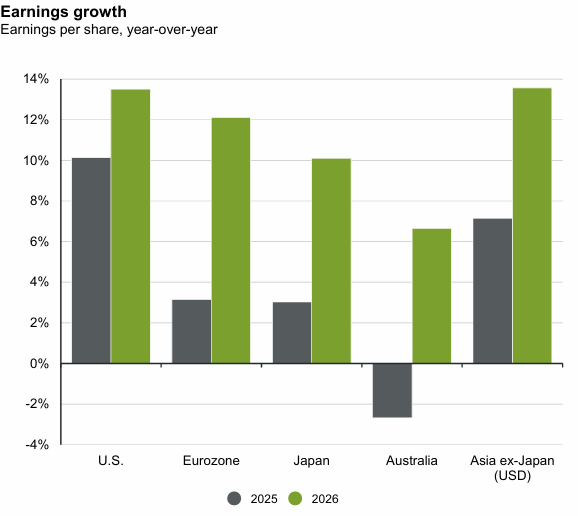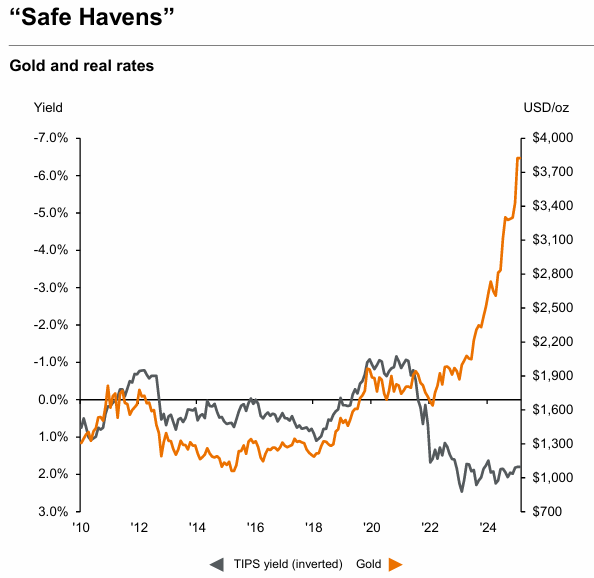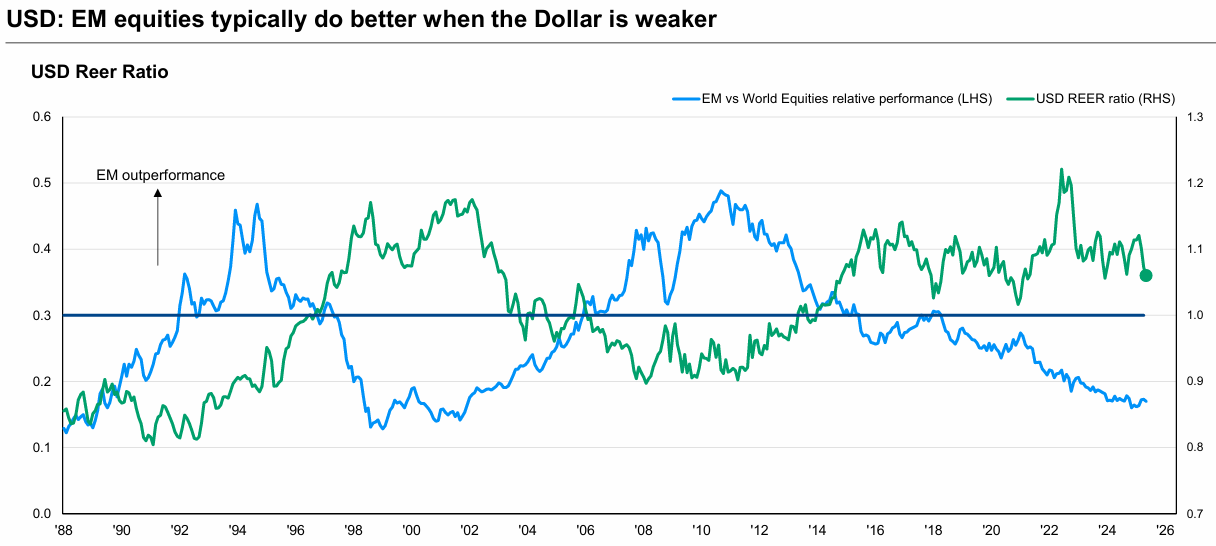JP Morgan Asset Management’s take on growth, risk and opportunity
At JP Morgan Asset Management’s October briefing, two of the firm’s sharpest minds unpacked a world that refuses to slow down.
Kerry Craig, Global Market Strategist, has spent years reading the pulse between macro data and market emotion.
Sonal Tanna, Head of the Global Emerging Markets Core Team and Portfolio Manager, offered the view from the front line, where policy shifts, capital flows and opportunity collide across developing markets.
“Macro data has been pretty resilient around the world,” said Craig. “You’ve got improving trade dynamics, an economy that’s not falling into recession, and easy monetary policy, that still lifts risk assets overall.”
Tanna agreed that resilience runs deeper than headlines suggest. “What’s been plaguing emerging markets for the last decade has been dollar strength,” she said. “Now, at least, we’ve turned that from a headwind to a mitigation of a headwind, even if it’s not continued dollar weakness.”
In this wire, we unpack JP Morgan’s stance on global growth, rates, and risk, what’s driving the soft landing, where the real value lies, and how investors can position for what comes next.

A soft landing that's holding
Resilient data and easy policy have kept the cycle alive longer than most anticipated. The questions Craig hears most often centre on the "melt-up" in risk assets, a rally that continues despite a backdrop of geopolitical tension and patchy data. His answer is straightforward: the fundamentals remain too solid to ignore.
Improving trade flows, resilient earnings, and a global economy that’s “not falling into recession” are keeping sentiment buoyant. The soft landing that many dismissed six months ago has, so far, held.
Australia, in particular, stands out for its staying power. Craig highlighted that consumption and household incomes have been far stronger than expected, buoyed by easing price pressures, rate relief, and tax cuts that have boosted spending capacity.
Real disposable income, he said, continues to rise, supporting the household sector that remains the country’s key growth driver.
That mix of steady demand and improving household finances points to what Craig called “a resumption in quite strong consumption growth” as the economy edges back toward its potential rate of expansion.
Still, he added a note of realism: the economy and the market don’t always move in tandem.
“In many places, the economy is not the market. It certainly feels like that in Australia as well.”
The US cycle and the path for policy
Across the Pacific, the world’s largest economy continues to run on momentum. Consumption remains the backbone of US growth, with spending proving far more resilient than forecasters expected.
“It’s still consumption that’s having a big impact on the outlook for the US economy,” Craig said. “The consumer has been remarkably resilient.”
Even so, JP Morgan expects a mild deceleration in the months ahead, not a downturn, but a slower grind toward trend growth. Craig noted that the US may face “a bit more of a slowdown over the last part of the year before picking up into next year… a little bit more of a bumpy path compared to what we hear in Australia.” Still, the firm sees “no recession growth that’s towards trend in the US and around the world.”
Inflation, meanwhile, is set to move modestly higher through mid-2026, driven in part by tariffs and supply-side pressures. Craig estimated that passing through half of the new tariff impact would lift inflation by about 0.7 percentage points. “You’re nearing three and a half percent,” he said, “but we don’t think it’s going to be a permanent change.”
That outlook supports JP Morgan’s view that the Federal Reserve will remain in easing mode, though the pace of cuts will depend on labour market conditions.
Craig sees “the Fed cutting rates again twice more this year and then potentially two more times next year, [and] an outside chance for a third rate cut depending on the slowdown of the labour market.”
Australia, however, presents a different picture. With consumption strong, inflation sticky, and housing activity buoyant, the Reserve Bank has little incentive to follow the Fed. As Craig put it, “It’s a pretty fine call whether the RBA actually does cut rates again in this cycle… the economy’s doing very well, inflation’s a bit sticky at the top of the band, [and] there’s no hurry to cut rates further.”

Gold's paradox: safety with volatility
Gold’s remarkable rally has left even seasoned strategists double-checking the fundamentals. The metal has surged far beyond what its relationship with real yields would normally justify, a move Kerry Craig described as “completely dislocated.”
Traditionally, gold shines when real rates are negative. But this cycle, other forces have taken the lead: lingering inflation fears, geopolitical tension, and a global shift away from US-denominated assets as central banks diversify reserves.
“You can see that COVID, inflation fears, geo risk, and a move away from holding US-based assets by central banks. All that contributed to a really strong rally."
Momentum, he added, could still carry prices higher. “It probably could go higher because the momentum is behind it. It’s priced in dollars, and we think the dollar is going through a longer-term decline.”
Even so, his message is one of restraint. Gold may act like a safe haven, but it's no low-volatility asset.
“One of the things people overlook with gold is that it’s volatile. The volatility of gold is pretty similar to equities in developed markets. Having too much of that in your portfolio just adds more volatility.”

Shifting tides in emerging markets
After years of underperformance, emerging markets are finally showing signs of life. The turning point, says Tanna, comes from one key shift: the US dollar is no longer the unrelenting headwind it once was.
For much of the past decade, any earnings growth EM companies achieved in local currency terms was wiped away by dollar strength. Now, that drag is easing.
“We’ve turned that from a headwind to a mitigation of a headwind,” even if it’s not continued dollar weakness.”

The shift has allowed many emerging-market central banks to join the global rate-cutting cycle, a move Tanna says is already supporting domestic demand.
“What we’ve started to see in earnest this year is the ability for emerging markets and for banks to join in that rate-cutting cycle, which has been much more supportive for domestic consumption.”
China remains a focal point, though Tanna stressed that the steady drumbeat of bad news has largely been priced in. “A lot of the bad news continues to come through, but it’s very well understood now. There is policy support which provides downside protection, particularly in areas like housing.”
At the same time, Asia’s technology engine is powering ahead. “While property has weighed on consumption, China is actually joining the rest of Asia Pacific in being increasingly dominant in technology. China, Taiwan and South Korea are big beneficiaries of the semiconductor cycle, particularly as it broadens out.”
Beyond China, India continues to shine. Tanna pointed to GDP growth north of 5%, underpinned by a multi-year capital expenditure boom following policy reforms. “There’s good support now from public-sector CapEx and supportive policy from the Reserve Bank,” she said.
Valuations have already started to re-rate, but JP Morgan still sees upside.
“We’re now closer to 15 times earnings and we’re seeing a better earnings picture and more confidence driven by stabilisation in China, solid underpinnings from India, and sectors like technology contributing to growth.”
The bottom line
“We would still have a relatively pro-risk stance despite the value we’ve seen in markets,” Craig concluded.
“We’re conscious of valuations and relative positioning, but this is still a market where you want exposure to equities and corporate credit and increasingly, opportunities around the world.”
For investors, JP Morgan’s message is clear: the soft landing is real but uneven, policy is easing, and diversification, not defensiveness, remains the smartest way to stay in the game.
4 topics
1 contributor mentioned

